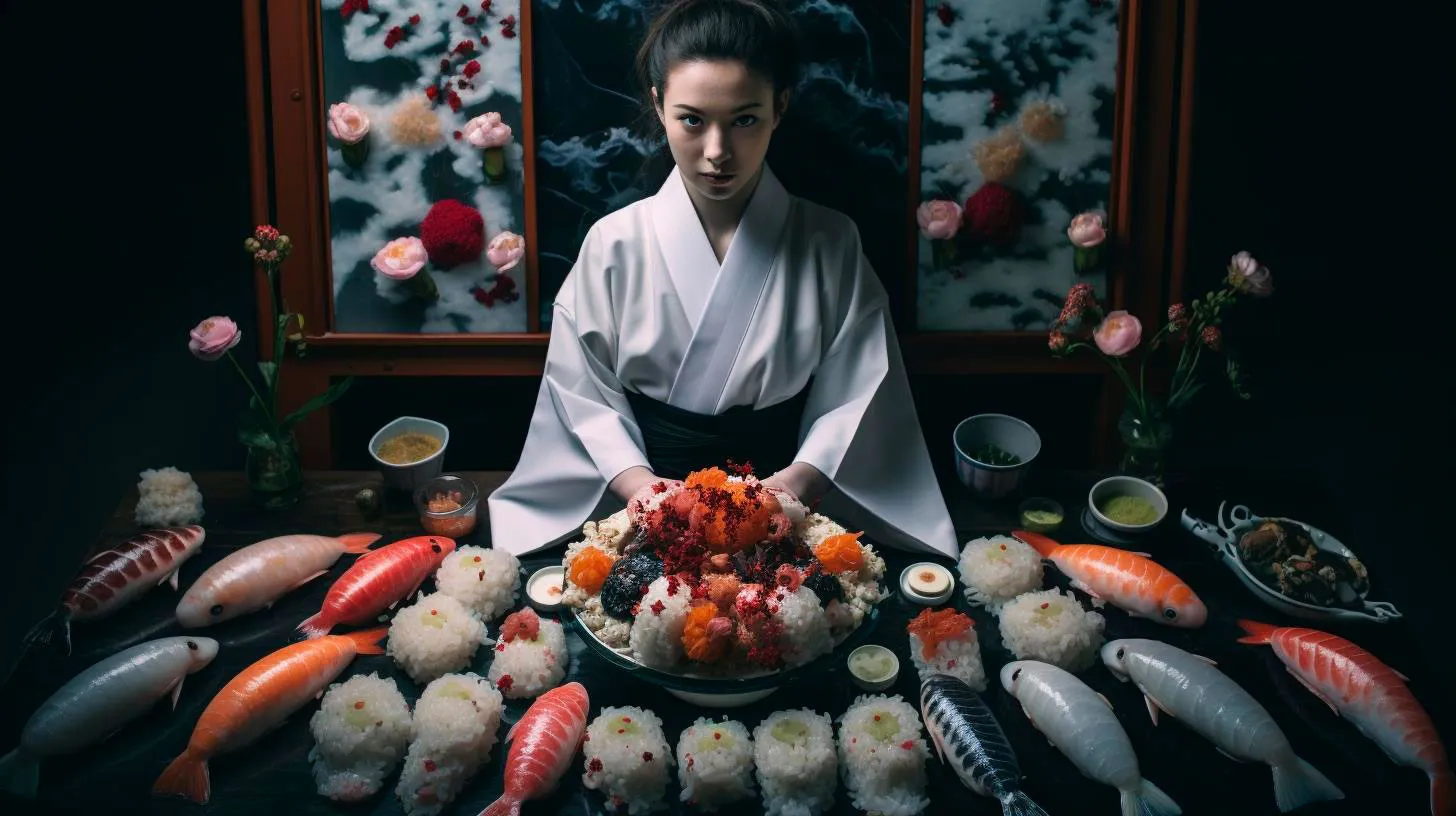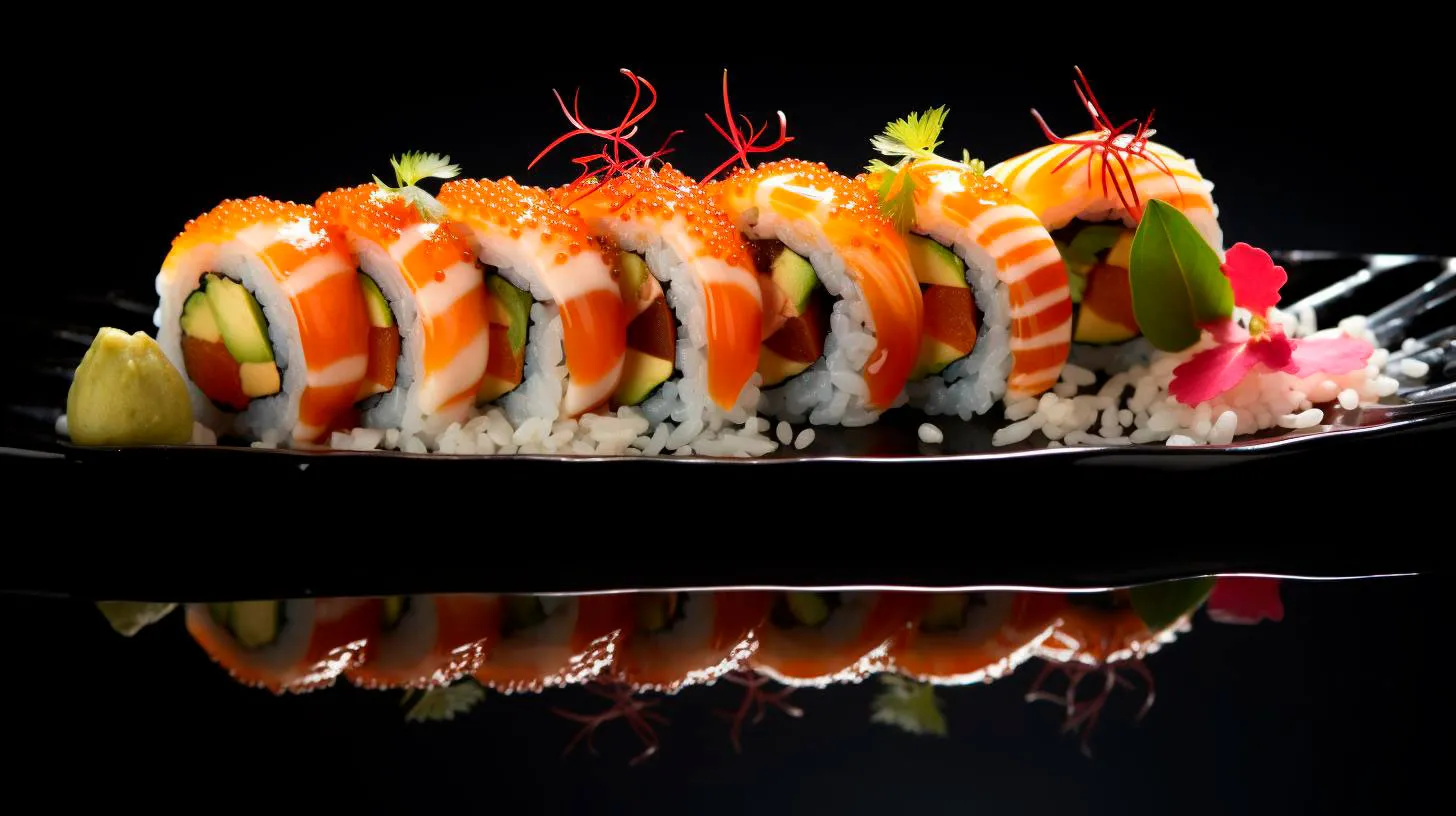Mastering the Legacy: Exploring Sushi History Through Cooking Education
The Origins of Sushi
Before we delve into the intricacies of sushi preparation, let’s take a moment to appreciate its humble beginnings. Sushi originated in Southeast Asia, where it was initially developed as a means of preserving fish, a vital source of nutrition in the region. The practice of fermenting cooked rice, known as narezushi, allowed fish to be stored for extended periods without spoiling.
Over time, sushi evolved and adapted as it made its way to Japan. The Japanese introduced a new element to the dish – raw fish. By combining vinegared rice with fresh fish, sushi took on a new dimension, becoming the delicacy that we know today.
Key Takeaway: Sushi originated as a food preservation technique in Southeast Asia and transformed into the modern delicacy we enjoy in Japan.
The Art of Sushi Making
Preparing sushi is an art form that requires precision, patience, and a deep understanding of ingredients. Let’s explore the key elements involved in creating this culinary masterpiece:
1. Rice: The Foundation of Sushi
Creating perfect sushi rice is an essential skill. The rice must be properly cooked, seasoned with a mix of vinegar, sugar, and salt, and then cooled to the right temperature. This sticky, yet fluffy rice serves as the foundation for a sushi roll or nigiri.
2. Nigiri: Crafting Every Piece
Nigiri is a form of sushi that consists of a small ball of rice topped with a slice of fish or other seafood. The chef must carefully shape the rice, ensuring the perfect balance between the rice and the topping. This technique requires precision and attention to detail.
3. Maki Rolls: The Art of Rolling
Maki rolls are perhaps the most recognizable form of sushi. The combination of rice, fish or vegetables, and seaweed is rolled together using a bamboo mat. The process involves a delicate balance of ingredients and technique to create a visually appealing and delicious roll.
Key Takeaway: Sushi making is an art that requires skill and attention to detail, with the perfect balance of rice, fish, and vegetables in every bite.
The Evolution of Sushi
Throughout history, sushi has continuously evolved, adapting to different tastes and preferences. Traditional sushi, also known as Edo-style sushi, emphasizes the natural flavors of the fish. However, innovation has paved the way for various sushi styles:
1. Nigiri Zushi: Simple Perfection
Nigiri zushi remains one of the most authentic and traditional forms of sushi. With a simple combination of rice and topping, nigiri showcases the natural essence of the fish. It is a true testament to the delicate balance and flavors that sushi embodies.
2. California Roll: A Western Twist
The California roll revolutionized sushi consumption in the Western world. Using avocado, cucumber, and crab meat, it offered a milder flavor profile and introduced sushi to a broader audience. The California roll serves as an entry point for those new to sushi.
3. Fusion Sushi: Blending Cultures
Fusion sushi merges traditional Japanese sushi with elements from various cuisines. It introduces unique flavors and combinations, such as sushi with a Mexican twist or incorporating ingredients like cream cheese or spicy mayo. This fusion represents the constant evolution of sushi.
Key Takeaway: Sushi continues to evolve, with traditional styles showcasing the essence of the fish and fusion varieties introducing innovative flavors and combinations.
The Significance of Sushi Education
Mastering the art of sushi making goes beyond creating a delicious meal. It provides a deeper understanding of Japanese culture and the interplay between tradition and innovation. By exploring sushi history through cooking education, we gain insights into the following:
1. Cultural Appreciation
Learning about the origins of sushi and its cultural significance fosters a deeper appreciation for the art form. It helps us understand the historical context from which sushi emerged and the techniques that have been passed down through generations, keeping the legacy alive.
2. Mastery of Technique
Sushi making requires dedication and practice to achieve mastery. By undertaking cooking education focused on sushi, individuals develop essential skills, such as rice preparation, knife techniques, and presentation. This mastery not only enhances culinary abilities but also instills discipline and attention to detail.
3. Creative Expression
While sushi has a rich tradition, it also encourages innovation and creativity. Through cooking education, individuals can experiment with flavors, textures, and presentation techniques, creating unique sushi experiences that showcase their own personal touch. Sushi becomes a canvas for culinary exploration.
Key Takeaway: Cooking education focused on sushi provides cultural appreciation, mastery of technique, and a platform for creative expression.
As we conclude our journey through sushi history, let us not only appreciate the flavors but also the spirit of innovation and cultural heritage encapsulated within each piece of sushi. By mastering the legacy of sushi through cooking education, we can savor the past while preparing for a future where this ancient art form continues to amaze and captivate the world.
Preserving Centuries of Flavor: Sushi Cooking Schools Keeping Time-Honored Traditions Alive
Behind every exceptional sushi dish lies the knowledge, skills, and traditions preserved by sushi cooking schools.
In recent times, sushi cooking schools have gained popularity not only among aspiring chefs but also among food enthusiasts who want to master the art of crafting authentic sushi. These schools aim to impart the time-honored techniques and instruct students on how to preserve centuries of flavor in their creations. Let’s dive deeper into the world of sushi cooking schools and explore how they contribute to the preservation of this esteemed culinary tradition.
Preserving Tradition through Education
Sushi cooking schools serve as guardians of tradition, ensuring that the art of sushi-making is passed down from generation to generation. By providing comprehensive educational programs, these schools equip aspiring chefs with the necessary knowledge and skills to create sushi dishes that uphold the time-honored techniques and flavors.
Key takeaways from sushi cooking schools:
- Mastering the fundamentals of sushi preparation, including rice cooking, slicing fish, and forming different types of sushi rolls.
- Discovering the art of presentation, highlighting the visual appeal and balanced composition of sushi plates.
- Preserving the traditional sushi etiquette, such as proper use of chopsticks, appropriate dipping practices, and mindful consumption.
- Understanding the importance of sourcing fresh and sustainable ingredients to maintain the authenticity and quality of sushi.
- Learning about the cultural significance and history of sushi, fostering a profound respect for this culinary art form.
The Advantages of Sushi Cooking Schools
Enrolling in a sushi cooking school offers numerous advantages for both aspiring chefs and sushi enthusiasts:
- Specialized Knowledge: Sushi cooking schools provide in-depth knowledge about the history, techniques, and cultural context of sushi preparation.
- Hands-On Experience: Students receive hands-on training, allowing them to refine their knife skills, rice preparation, and sushi rolling techniques under the guidance of experienced instructors.
- Networking Opportunities: These schools often organize events, workshops, and networking sessions, bringing together sushi professionals, enthusiasts, and industry experts.
- Creating Authentic Flavors: With proper training, students can recreate the authentic flavors of traditional sushi, elevating their culinary creations.
- Career Growth: For aspiring sushi chefs, attending a reputable cooking school enhances their chances of securing positions in renowned sushi restaurants or even opening their own establishments.
Sushi Cooking Schools: A Growing Trend
The popularity of sushi cooking schools is on the rise, reflecting the increasing demand for authentic sushi experiences globally. As per industry statistics:
- In the United States, sushi consumption has grown by over 20% in the last decade, contributing to the surge in the number of sushi cooking schools across the country.
- In Japan, the birthplace of sushi, cooking schools are experiencing a revitalization of interest among both locals and international visitors who wish to learn the art of sushi-making firsthand.
- The global sushi market is expected to reach a value of $22.9 billion by 2027, affirming the enduring appeal of this cuisine across different cultures.
In conclusion, sushi cooking schools play an essential role in preserving centuries of flavor by imparting knowledge, skills, and traditions to future generations of chefs. By embracing these educational opportunities, aspiring sushi chefs can elevate their craft and contribute to the authenticity and longevity of this revered culinary tradition. So whether you’re a passionate food enthusiast or dreaming of becoming a sushi chef, enrolling in a sushi cooking school is a rewarding adventure that will keep the time-honored flavors alive for centuries to come.
Reviving Ancient Techniques: Studying the Art of Sushi Craftsmanship
Today, we explore how technology is playing a significant role in preserving and reviving these time-honored techniques.
The Evolution of Sushi Craftsmanship
Sushi, initially considered street food in Japan, has evolved into an exquisite delicacy appreciated worldwide. This transformation is a testament to the meticulous craftsmanship that takes place behind the sushi counter. Traditionally, sushi chefs go through years of rigorous training to master every aspect of this ancient culinary art.
Unfortunately, in recent years, a shortage of skilled sushi chefs has emerged due to various reasons, including the time required to train an apprentice and the demanding nature of the job. The urgency to preserve and pass on these skills has never been greater.
Preserving Techniques Through Virtual Reality
The marriage of technology and sushi craftsmanship might seem unlikely at first glance, but the advent of virtual reality (VR) has opened new avenues for preserving and learning ancient techniques. VR technology allows aspiring sushi chefs to step into the virtual world and immerse themselves in an authentic sushi-making experience.
VR platforms offer detailed step-by-step tutorials, providing users the opportunity to learn and practice sushi-making techniques virtually. By replicating the motions and sensations involved in preparing sushi, this technology enables new generations of chefs to gain a deeper understanding of traditional methods.
Moreover, VR simulations allow for experimenting with different ingredient combinations and presentation styles, ultimately fostering creativity in sushi-making. The technology helps chefs push the boundaries of traditional sushi while still honoring the essence of this art form.
Enhancing Precision and Efficiency with Robotics
Robotics is another realm in which technology is revolutionizing sushi craftsmanship. Traditional sushi-making requires immense precision, concentration, and consistency. By integrating robotics into the process, chefs can elevate their craft to new heights while reducing the demand for highly skilled chefs.
Robotic sushi-making machines are capable of producing perfect nigiri, maki, and sashimi with incredible speed and accuracy. These machines can replicate the movements and techniques of expert sushi chefs, ensuring consistent results every time. With the assistance of robotics, sushi chefs can focus on providing unique flavors and experimenting with innovative ingredients.
The Future of Sushi Craftsmanship
As technology continues to advance, it has become a valuable tool in preserving and enhancing the art of sushi craftsmanship. Let’s summarize the key takeaways from our exploration:
- Virtual reality offers aspiring sushi chefs an opportunity to learn and practice traditional techniques in a virtual environment.
- VR simulations allow for creativity and experimentation, without compromising the essence of sushi-making.
- Robotics in sushi-making enables precision, consistency, and speed while reducing reliance on highly skilled chefs.
With these advancements, it is essential to strike a balance between innovation and tradition. While technology helps preserve ancient techniques, it is crucial that these innovations complement the spirit and values of sushi craftsmanship.
Intrigued by the Art of Sushi Craftsmanship?
If the world of sushi craftsmanship fascinates you, why not explore it further? Consider trying your hand at creating sushi at home or visiting a traditional sushi restaurant to witness the mastery in action. Embrace the combination of technological progress and age-old techniques, and you’ll gain a newfound appreciation for this ancient culinary art.
Thank you for joining us on this journey through the revival of ancient techniques in sushi craftsmanship. Stay tuned for more captivating tech insights in our future blog posts!
Nurturing Culinary Heritage: Unraveling the Secrets of Traditional Sushi Making
The Origins of Sushi
Sushi has its roots in ancient Japan, where it was first mentioned in the 8th century. Originally, sushi was a preservation method that involved fermenting fish with rice and salt. Over time, the process evolved, and sushi became a delicacy appreciated for its taste and presentation. Today, sushi has gained global popularity, with various regional and international adaptations.
Traditional Sushi Making Techniques
Creating traditional sushi involves a meticulous combination of ingredients, precise knife skills, and a deep understanding of flavor balance. Here are some key techniques and ingredients that make traditional sushi a truly authentic experience:
- Sushi rice: The foundation of every sushi roll is the perfectly seasoned sushi rice. Short-grain Japanese rice is cooked with vinegar, sugar, and salt, giving it a sticky texture and a hint of sweetness. The rice is then cooled and expertly shaped to hold the desired fillings.
- Sashimi: Sashimi refers to thinly sliced raw fish or seafood. It is a key component in traditional sushi, providing a fresh and succulent taste. Careful selection and handling of sashimi-grade fish is crucial to ensure its quality and safety.
- Nigiri: Nigiri sushi consists of a small mound of sushi rice with a slice of fresh fish or seafood on top. The rice is delicately molded by hand, taking into account the texture, temperature, and shape of the topping.
- Maki: Maki sushi is created by wrapping sushi rice and various ingredients like fish, vegetables, or pickles in a sheet of nori seaweed. The roll is then carefully sliced into bite-sized pieces.
Paying Homage to Tradition
Traditional sushi making is an art form that is deeply rooted in Japanese culture. While contemporary sushi variations exist, it is important to preserve the techniques and traditions that have been passed down through generations. Here’s why:
- Cultural heritage: Traditional sushi making is an essential part of Japan’s cultural heritage. By preserving these age-old techniques, we honor the culinary traditions and customs that have shaped our society.
- Authentic flavors: Traditional sushi offers a unique taste experience that is carefully curated to highlight the freshness and natural flavors of the ingredients. By following traditional methods, we ensure that these flavors are not compromised.
- Craftsmanship: The art of sushi making requires immense skill, precision, and attention to detail. By nurturing the traditional techniques, we celebrate the craftsmanship and dedication of sushi artisans.
Key Takeaways
Unraveling the secrets of traditional sushi making allows us to fully appreciate the depth of this culinary art form. Here are the key takeaways:
- Traditional sushi making techniques have evolved over centuries, reflecting the cultural heritage of Japan.
- Ingredients like sushi rice, sashimi, nigiri, and maki are crucial for creating authentic and flavorsome sushi.
- Preserving traditional sushi making techniques honors cultural heritage, ensures authentic flavors, and celebrates craftsmanship.
So, the next time you savor a piece of traditional sushi, let it be an experience that not only satisfies your taste buds but also transports you to the heart of Japanese culinary traditions. Nurture the heritage, embrace the flavors, and appreciate the artistry that goes into every bite.



